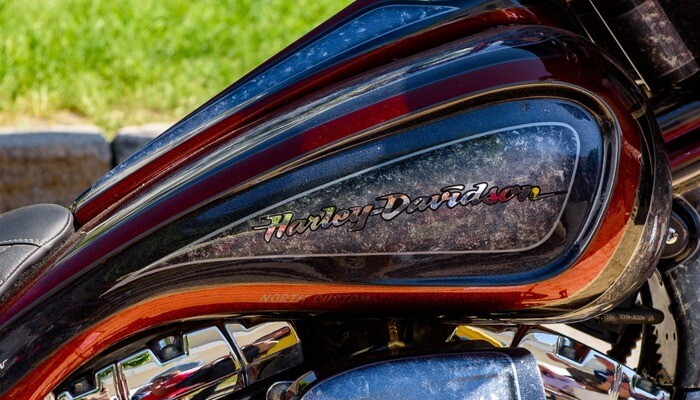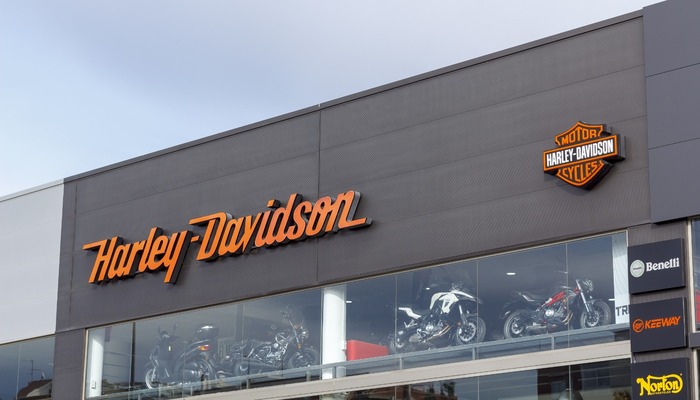Motorcycle brand Harley-Davidson has risen to iconic status since its establishment in 1903, thanks to its portfolio of masculine bikes, reputable engineering, and easily customisable builds. Indeed, its popular array of chopper and cruiser motorcycles have gained a cult following, revving the company's sales for decades and making it the preferred manufacturer for many around the world.
Despite its impressive legacy, however, Harley is becoming increasingly associated with falling sales and loss of prestige. The company recently reported its 12th consecutive quarter of declining sales, which were some 5% lower than the previous year, representing the company’s worst financial results in over ten years.
In many circles, Harley's demise is greatly attributed to its weak marketing strategy – especially its inability to capture the attention of new generations of riders. As a result, the company is now focusing on an acceleration plan that aims to invigorate the brand and "spark passion that deepens rider commitment" among millennial consumers.
So, how has this once legendary manufacturer – now in its 117th year of operation – gotten itself into this undesirable situation? And, more importantly, what can you – as a business owner – learn from its mistakes?
Harley-Davidson's Marketing Strategy
Built around the central idea of giving customers a sense of freedom, Harley-Davidson rebranded itself as an American icon in the 1980s, transforming the company's fortunes and leveraging perceived weaknesses against superior Japanese engineering in its favour. A thriving subculture of customisation was also encouraged by the brand, with customers invited to fuel their imagination and adjust the many visual and functional elements of their machine. This was supplemented by high-quality customer aftercare, fulfilling the endless possibilities of riders' requests.
Crucially, the brand crafted a loyal following of motorcycle enthusiasts during this period, primarily through its community-building marketing efforts. At the core of these is the Harley Owner's Group (HOG), through which members can host and engage with a number of events, tours and initiatives that promote and protect the exclusivity of the brand. Unfortunately, this loyalty has come at the expense of alienating potential new, younger buyers who fall outside of the manufacturer's highly targeted traditional demographic.
While Harley adopts online and offline communications, participates in trade shows, executes brand events and maintains a dedicated mobile app, its marketing plan consistently fall short of achieving its customer acquisition ambitions. This is likely due to its inability to strike a balance between remaining authentic to the brand's origins, whilst evolving to meet consumers' current motorcycle needs and buyers' high moral expectations of global manufacturers.
Customer Profile
Harley-Davidson buyers are predominantly males, aged 55 and above. With a comfortable disposable income, they invest in these premium vehicles because they identify motorcycling as a passionate hobby of theirs. These consumers are ageing, however, and steadily outgrowing their interest in purchasing new bikes.
To ensure its survival, the company has added a new customer profile to its target demographic – that of motorcycle enthusiasts and non-riders between the ages of 22 and 38. Harley-Davidson is now targeting millennials with above-average income, banking on converting them into loyal followers that will carry the brand's proud history into the future.
However, this target consumer is vastly different from the typical Harley-Davidson owner. For a start, the millennial generation has strong opinions on the environmental impact of the automotive industry, something that poses a serious challenge for the gas-guzzling Harley product lineup.
Their reason for purchasing a bike also differs, with younger riders generally turning to two-wheel vehicles for convenience and ease of transportation, rather than to bask in the prestige of the brand or for recreational purposes. Harley-Davidson has thus far demonstrated unwillingness to evolve its brand perception enough to appeal to this consumer profile, to an almost frustrating extent. In 2018, for instance, the company quoted former senior vice president Willie G Davidson in reiterating that: "motorcycles have always been dramatic. They are not for everybody and never will be. This is a product that people can take to an extreme as a means of self-expression."
Marketing Mix
The brand adopts a varied marketing mix in its attempt to appeal to buyers. These include online and offline mediums that mainly focus on reinforcing Harley-Davidson's iconic brand image, positioning its products' premium status in the market, and engaging with its existing loyal following.
This marketing strategy falls short of the brand's customer acquisition objectives, though, most notably failing to leverage market segmentation for optimal results.
The Harley Owner's Group
At the centre of the company's community-building efforts is the aforementioned Harley Owner's Group. Launched in 1983, the HOG aims to engage with the brand's motorcycle enthusiasts as well as the wider public, and currently boasts more than one million members around the world.
Paid membership to the group gives fans access to personalised marketing communications, exclusive merchandise, and invitations to HOG events, as well as valuable services such as roadside assistance and insurance.
 Anton Ivanov Photo - stock.adobe.comCustomisation is seen as a hugely popular element of Harley-Davidson ownership
Anton Ivanov Photo - stock.adobe.comCustomisation is seen as a hugely popular element of Harley-Davidson ownership
Exhibits, Events and Tours
The brand organises, hosts and sponsors a range of activities for its riders that aim to foster the loyal Harley-Davidson consumer community further and drive passion for motorcycling as a hobby. Though this medium has been successful in retaining the company's buyers aged 50 and above, it could be better leveraged to engage with younger motorcycle enthusiasts.
The company could, for example, hold open events for millennial riders and engage with them to effectively raise awareness and generate demand for Harley's product range. Events could also become an integral component of the company's market research efforts, and be used to frequently collect feedback from young riders regarding their care-abouts and how the company could fulfil these.
Harley-Davidson Riding Academy
The motorcycle manufacturer operates an eponymous riding school, including a new rider course designed to introduce fresh consumers to the motorcycling experience. Although a potentially beneficial approach to customer acquisition, the programme's approach still heavily utilises Harley's outdated brand positioning, to the detriment of attracting potential riders.
Take the course's promotional video, for instance. "Why did I take this class?", the voiceover intones. "Because, who doesn't want to ride a Harley?" This opening statement, arguably the marketing collateral that will be the first point of contact for interested parties researching the academy, offers no real information as to the benefits of the programme. More importantly, however, it once again demonstrates Harley's overconfident dependence upon its former prestige to garner riders' interest, disregarding the fact that this approach has already proven unsuccessful in attracting new consumers.
Mobile App
The Harley-Davidson mobile app gives users access to tools that help them get the most out of their time on the road. The app's Ride Planner allows Harley riders to plan, edit and follow custom routes while using in-app GPS navigation, tracking useful details such as available gas stations and nearby restaurants. The application also acts as a digital hub for bike customisation options, local dealership details, and other relevant tidbits.
However, despite offering an abundance of significant information, the app lacks any innovative features that could make it attractive to millennial consumers. VR riding experiences, for example, would give users a sneak peek into the thrill of motorcycling from the comfort of their home, sparking interest in further exploring the brand's offering. Engaging video and photographic content generated by customers and influencers alike could, meanwhile, promote Harley's products as well as showcase the exhilarating biking experience and lifestyle through the app. This is a technique that has been expertly adopted by Red Bull, for example, to huge success.
Style
Harley-Davidson's marketing style has traditionally been rigid, focusing on engaging with a very limited customer profile that has left no room for natural consumer succession and business growth over the years. Moreover, the company has long been occupied with promoting and reinforcing its image as an all-American premium brand that specifically caters to "rough-and-tumble", independent riders. This image has alienated consumers outside of that category, and led potential buyers to avoid Harley bikes because of its brand positioning.
Though the company has reportedly taken measures to turn its marketing around and appeal to the younger generation in order to save its future, it has yet to strike the required balance that will result in increases in both sales and customer breadth.
Trying to Make a Change: The Harley-Davidson LiveWire
Perhaps the greatest example that Harley's marketing strategy is the root of its current challenges is the launch of its newest motorcycle, the LiveWire, which is designed to target environmentally aware millennial riders.
The company's first-ever electric bike, the LiveWire was launched in early 2020 with the aim of attracting some 2 million new consumers to the brand over the course of the next ten years. It purportedly fits customers who are looking for a new riding experience by providing "instant acceleration combined with sophisticated technology".
However, despite producing a product that addresses the environmental concerns of their ideal buyers, marketing of the LiveWire itself has been unsuccessful in raising even moderate excitement among millennials. There are several reasons for this.
For starters, Harley-Davidson failed to give its brand image a much-needed revamp ahead of the product launch. The legacy of the company is still immediately brought to the mind of consumers both young and old, which could have been addressed by encouraging new connections with automotive technology, innovation, and modern design – a concept that many of its rivals (particularly Honda) are getting right. This shift in perception could have been achieved through digital and broadcast advertising campaigns, as well as ambient and guerrilla marketing.
The company also arguably miscalculated its pricing strategy, mistakenly considering that the manufacturer's premium status would draw buyers irresistibly to the LiveWire (as it may have done in the past with loyal riders). The truth is that, with a price range of circa $30,000, the vehicle's cost rivals several other luxury, equally environmentally-friendly vehicles available on the market. Indeed, as an example, the Tesla Model 3 retails at $35,000. As yet, no product promotions, discounts or offers have been released to give riders a financial incentive to buy.
Although product placement was initially adopted in the run-up to LiveWire's release, this marketing strategy could also have been better utilised to support sales of the motorcycle. The brand invested heavily in embedding the LiveWire in the 2015 blockbuster, Avengers: Age of Ultron; however, the collaboration was used to gauge audience reception and perception of the motorcycle rather than drive demand for it. This placement took place too far ahead of the product's 2020 release to have any significant impact on customer acquisition and sales.
At the time of writing, the company has yet to release any data concerning LiveWire sales, but the lack of significant market reaction indicates that it is likely to be another disappointment for the declining brand.
---
Harley-Davidson is facing major issues as its customer base ages and loses interest in their high-velocity motorcycling hobby. Even in the US, which has traditionally been fiercely loyal to the brand, the company reported its lowest US sales in 16 years earlier this year. Having identified its growing issues, however, the brand is attempting to appeal to a new generation of riders, and an overhaul of its marketing strategy could certainly support this.
To fulfil its goals, Harley will need to focus more on detailed customer segmentation, adoption of integrated and innovative promotional techniques, and, above all, invest in updating its outdated brand identity.
Though the brand's legacy is beginning to fade, it's never too late to attempt to turn it around and give new consumers a reason to approach Harley-Davidson for their motorcycle needs. Only time will tell if the iconic motorcycle manufacturer is up to the challenge.
What do you think? Join in the conversation and let us know in the comment section below!
